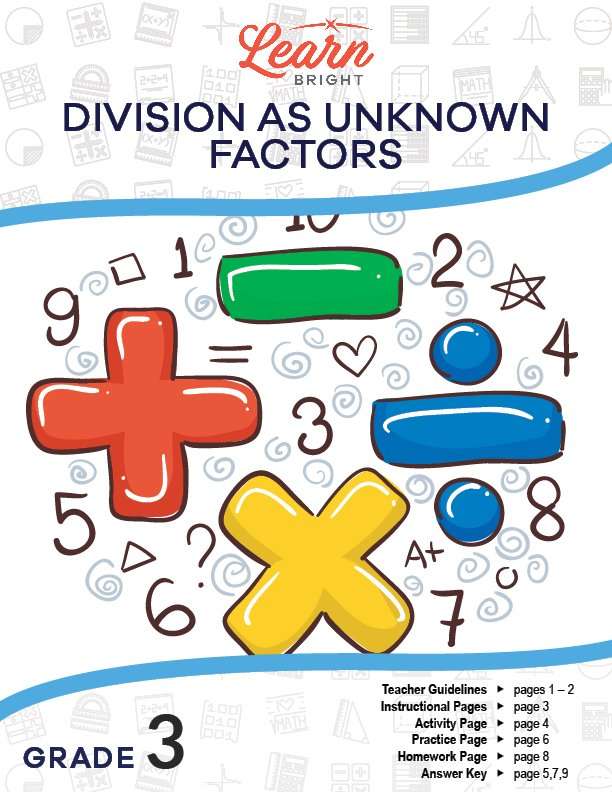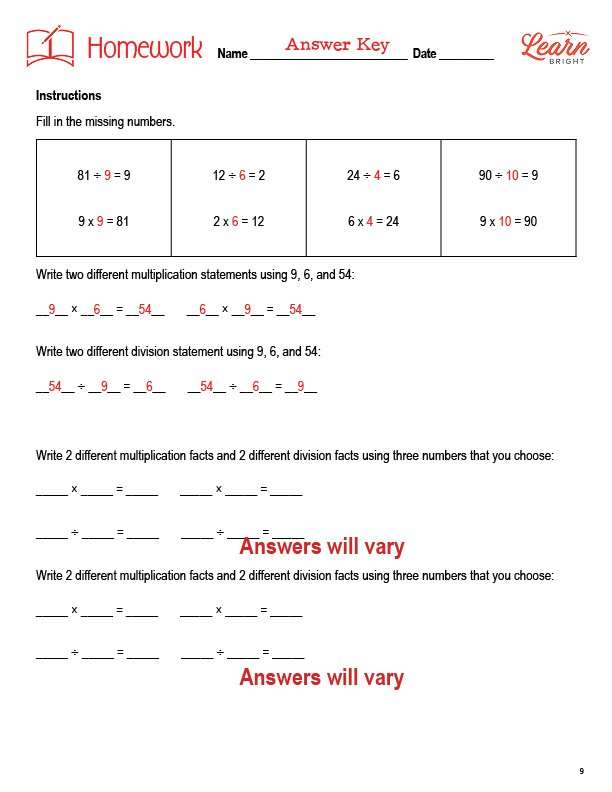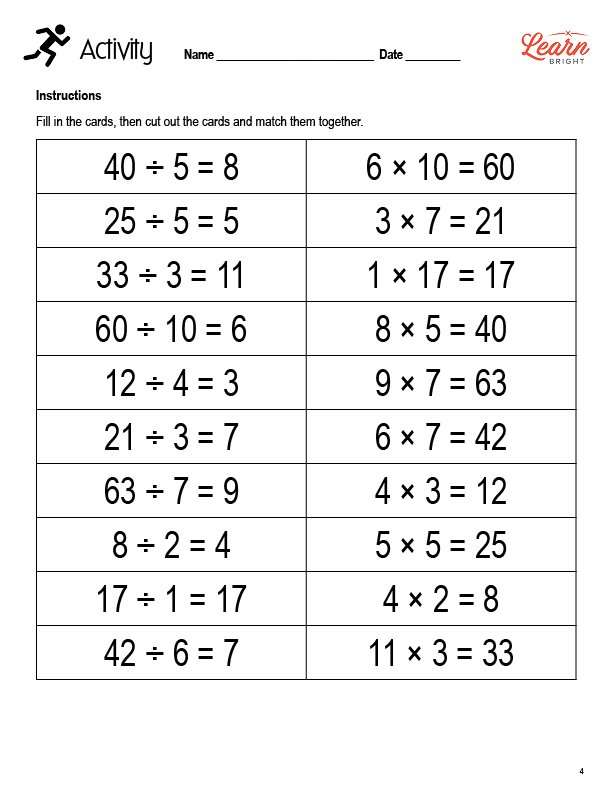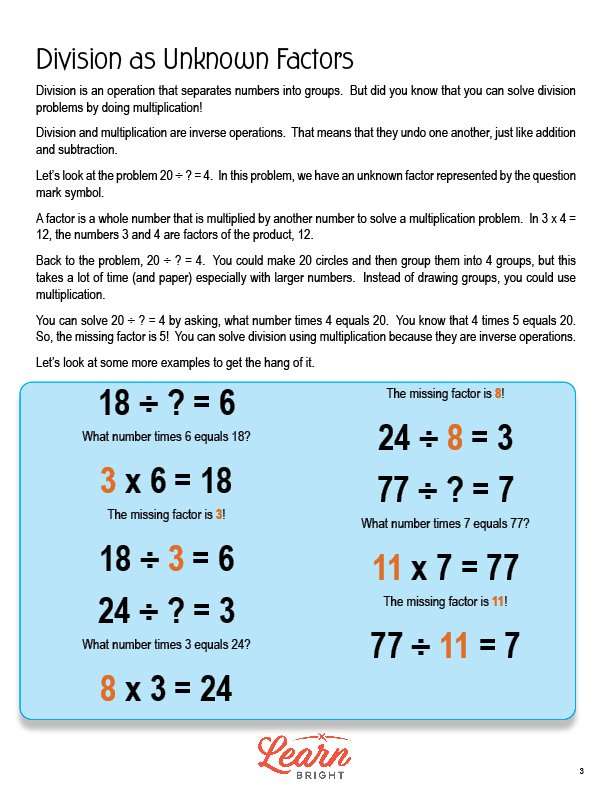Description
What our Division as Unknown Factors lesson plan includes
Lesson Objectives and Overview: Division as Unknown Factors teaches students about how missing factors can be found in division and multiplication problems. At the end of the lesson, students will be able to understand division as an unknown-factor problem. This lesson is for students in 3rd grade.
Classroom Procedure
Every lesson plan provides you with a classroom procedure page that outlines a step-by-step guide to follow. You do not have to follow the guide exactly. The guide helps you organize the lesson and details when to hand out worksheets. It also lists information in the blue box that you might find useful. You will find the lesson objectives, state standards, and number of class sessions the lesson should take to complete in this area. In addition, it describes the supplies you will need as well as what and how you need to prepare beforehand. The supplies you will need for this lesson include paper, scissors, and glue.
Options for Lesson
Included with this lesson is an “Options for Lesson” section that lists a number of suggestions for activities to add to the lesson or substitutions for the ones already in the lesson. One optional addition to this lesson is to have your students write out fact families of different factors in order to find the unknown factor of a division problem. You could also have your students find unknown factors in a scavenger hunt. Finally, you could have one of your students ‘teach’ another student who is the ‘learner’ in order to solidify the concept of inverse operations.
Teacher Notes
The teacher notes page includes a paragraph with additional guidelines and things to think about as you begin to plan your lesson. This page also includes lines that you can use to add your own notes as you’re preparing for this lesson.
DIVISION AS UNKNOWN FACTORS LESSON PLAN CONTENT PAGES
Division as Unknown Factors
The Division as Unknown Factors lesson plan includes one content page. Division separates numbers into groups. Did you know that you can solve division problems using multiplication? Division and multiplication are inverse operations, which means that they undo one another. Addition and subtraction are also inverse operations.
For example, take the problem 20 ÷ ? = 4. This problem includes an unknown factor, represented by a question mark. Factors are whole numbers that we multiply by another number in order to solve a multiplication problem. For the problem 3 x 4 = 12, the numbers 3 and 4 are factors of the product (12).
For the problem 20 ÷ ? = 4, you could solve for the unknown variable by drawing 20 circles and then dividing them into four groups. However, this method would be time consuming and inefficient, especially if you needed to work with large numbers. Instead of using this method, you can multiply instead!
To do this, you just need to ask yourself what number times 4 equals 20. Because you know that 4 times 5 equals 20, you know that the missing factor is 5. You can solve problems this way because division and multiplication are inverse operations.
The lesson closes with a few more examples. One of these is the problem 18 ÷ ? = 6. To solve using multiplication, you need to ask yourself what number times 6 equals 18. The answer is 3, so the missing factor is 3!
DIVISION AS UNKNOWN FACTORS LESSON PLAN WORKSHEETS
The Division as Unknown Factors lesson plan includes three worksheets: an activity worksheet, a practice worksheet, and a homework assignment. You can refer to the guide on the classroom procedure page to determine when to hand out each worksheet.
MATCHING ACTIVITY WORKSHEET
For the activity worksheet, students will fill in the cards on the worksheet. They will then match them together.
MISSING NUMBERS PRACTICE WORKSHEET
The practice worksheet asks students to first find the missing numbers in division and multiplication problems. They will then write two different multiplication statements and two different division statements using 15, 3, and 5. Finally, they will write two different multiplication statements and two different division statements using 9, 72, and 8.
DIVISION AS UNKNOWN FACTORS HOMEWORK ASSIGNMENT
For the homework assignment, students will complete several short exercises. For the first, they will find the missing numbers in division and multiplication problems. For the second, they will write two different multiplication statements and two different division statements using 9, 6, and 54. Finally, they will write 2 different multiplication facts and 2 different division facts using three numbers that you choose twice, using a different set of numbers.
Worksheet Answer Keys
This lesson plan includes answer keys for the activity worksheet, the practice worksheet, and the homework assignment. If you choose to administer the lesson pages to your students via PDF, you will need to save a new file that omits these pages. Otherwise, you can simply print out the applicable pages and keep these as reference for yourself when grading assignments.









